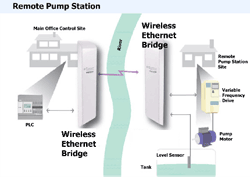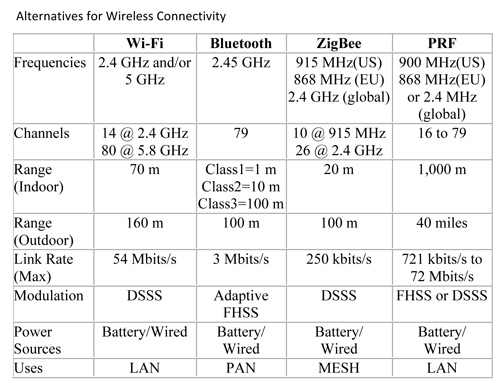Six sure-fire tricks to prevent wireless connectivity
Better connectivity demands avoiding simple mistakes
BY ANDREW C. ROSS
Director of Wireless Applications
B&B Electronics
www.bb-elec.com
Advances in industrial Ethernet have made it possible to get just about any device to communicate over a network. A USB-to-serial server, for example, will network-enable legacy serial devices that were built before the USB specification came into existence. Engineers have worked out the ways to smoothly transfer data between whatever protocols are appropriate for the task at hand, be it TCP/IP to Modbus or Profibus to USB. At the physical layer, a network may be a mix of copper cable and fiber optics, and it may sprawl across numerous buildings or an entire campus.
Steady improvements in wireless technology are now allowing a greater number of devices to establish wireless connectivity with the same reliability already achieved by cable communications. Better still, it is becoming possible to make these kinds of connections in increasingly difficult environments. That doesn’t mean, however, that you can’t step on your own toes and prevent it from happening. This article will describe some of the things that you can do to frustrate your own plans.
1. Forget about signal echo
The typical open radio frequencies (900 MHz and 2.4 GHz) used for wireless data connectivity applications have a reasonable penetration range in buildings built with wood frame and drywall. But watch what happens when you try to set up a wireless network in an older building where the walls are made of plaster on a galvanized wire mesh. The CIA offices in Moscow can be assumed to have more advanced methods for interfering with radio signals. But for any ordinary purposes, plaster on wire mesh isn’t half bad.
Dense building materials like concrete will also interfere with radio signals, especially if the concrete is reinforced with metal rebar. Large metal objects like industrial machinery will do the same. This bounce can redirect the data signal and return it to the original transmitter, causing an “echo” or “multi-path”. First-generation wireless systems were easily confused by this type of interference and would cancel transmission all together. The result was a state referred to as “radio null” and it prevented data communication.
Several transmission and modulation schemes have been developed to counter the effects of echo. One of the best is FHSS (Frequency Hopping Spread Spectrum), in which data is transmitted on a single channel, but the channel is constantly changing or “hopping”. This scheme requires low bandwidth. Another excellent choice is DSSS (Direct Sequence Spread Spectrum), in which data is transmitted simultaneously over every available channel, making it a bit more reliable in “noisy” environments. DSSS has the disadvantage of being more bandwidth intensive.
Note that all of the wireless transmitters, nodes and equipment on your network must support the same transmission scheme to connect properly.
2. Ignore electromagnetic interference (EMI)
The electromagnetic emissions created by large motors, heavy equipment, high power generation and usage, and other typical industrial machinery can create extremely high levels of “noise”, which interferes with wireless connectivity. In these “noisy” environments, transmitters and remote nodes are unable to “hear” each other, resulting in frequent data loss. Frequency Hopping Spread Spectrum (FHSS) and Direct Sequence Spread Spectrum (DSS) will help with this problem as well.
3. Just park your antenna anywhere and walk away
Antennas increase their effective power by focusing the radiated energy in the desired direction. Using the correct antenna not only focuses power, it reduces the amount of power broadcast into areas where it is not needed. But one symptom of the increasing popularity of wireless is the fact that everyone seeks out the highest convenient places to mount their antennas. It’s not uncommon to arrive at a job site to find that other antennas are already sprouting all over your installation point. Even if you suspect that these systems are spread spectrum and likely to be using other ISM or licensed frequency bands, you’ll still want to maximize the distance between their antennas and your own. Most antennas broadcast in a horizontal pattern, so vertical separation is more meaningful than horizontal separation. Try to separate antennas with like-polarization by a minimum of two wavelengths, which is about 26 in. (0.66 m) at 900 MHz, or 10 inches (0.25 m) at 2.4 GHz.
Antennas can be directional, sending and receiving signals in a single direction. Examples would include dish, Yagi, and panel antennas. The advantage of a directional antenna is its greater range and its ability to focus coverage where it is needed. Antennas can also be omnidirectional, sending and receiving the signal in a linear radius. The advantage here is the antenna’s ability to communicate with a large number of nodes.
Proper antenna choice and location will have a big impact on your wireless connectivity.
4. Ignore range considerations
Wireless connectivity range is determined by four elements:
• Transmit power : Transmit power is the amount of power that is emitted from the antenna port of the wireless device. Proprietary RF is regulated in the US for up to 1 W. This provides substantial benefits when long ranges are needed, because the higher the transmit power, the “louder” the signal, and the farther it can travel.
• Receiver sensitivity : Sensitivity defines how well remote receivers can “hear” the signal. Sensitivity is significantly impacted by antenna type and hardware configurations.
• Line of sight (LOS) : As radio waves are elliptical, the fewer barriers along the LOS between receiver and transmitter, the better. Frequency and transmit power levels have the most impact on how well the signal can negotiate physical and EMI line of sight barriers.
• Data volume : Data rate and volume will impact your range. Large data packets are more difficult to transmit than smaller packets and will typically reduce range.
Choose equipment that will address these issues in a manner appropriate for the task at hand (see Fig. 1 ).

Fig. 1: Range considerations must be addressed by equipment in ways appropriate for the task.
5. Don’t worry about security
Chances are that your industrial network will be at least tangentially connected to an office LAN. Bear in mind that any Wi-Fi-enabled computer can connect to multiple networks at the same time. A hacker could use one of your employees’ laptops to access your network. An employee could bring your network down simply by wandering onto the wrong screen and hitting the wrong commands.
Don’t assume that your network is safe just because your premises are off the beaten path. Separate the office and industrial LANs with firewalls and employ robust security standards. Early wireless security standards like WEP (Wired Equivalent Privacy) turned out to be too weak — hackers didn’t have much trouble getting around them. You should consider more powerful standards like Extensible Authentication Protocol and Tunneled Extensible Authentication Protocol.
Also don’t assume that your wireless equipment has built-in security features. Be certain, one way or the other. Deploy inspection-type firewalls (such as packet filters) to control any access that is based on IP source address, destination address, and port number.
Change your passwords on a regular basis, and don’t make them easy to guess. A recent study has shown that some very popular passwords include “password,” “querty,” “abc123,” and “123456.” You can do better than that.

6. Install office-grade equipment
Industrial environments are harder on wireless equipment than any office would ever be. In a steel mill, for example, excessive heat, heavy vibration, and high levels of EMI will dramatically shorten the useful lifespan of your wireless equipment. You get what you pay for in this world, and using office-grade networking equipment to save small amounts of money up front will turn out to be a huge mistake when you have to pay for it later with downtime and repairs. ■
About the author
Andy Ross is currently the director of wireless applications for B&B Electronics and is an expert in M2M device networking. After serving as general manager of Mosaic Semiconductor, Ross moved to DPAC Technologies as director of technology, where he was responsible for the definition and development of advanced 3D packaging. Ross has served on the board of the JEDEC Solid State Technology Association, which sets the standards for the packaging and interfaces of semiconductors. He currently holds five US patents in advanced packaging technologies. Ross graduated from Sheffield Hallam University in the United Kingdom.
Advertisement
Learn more about B&B Electronics





